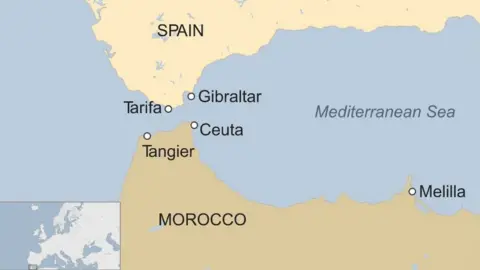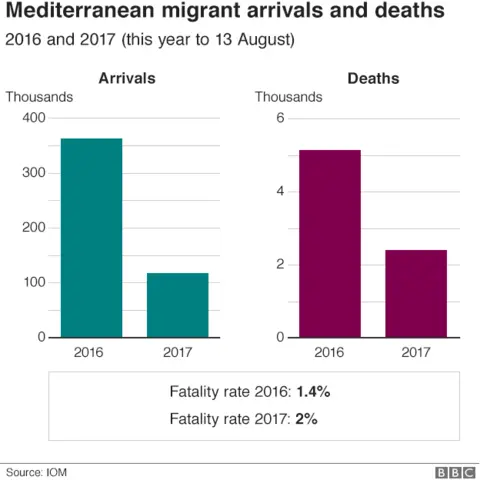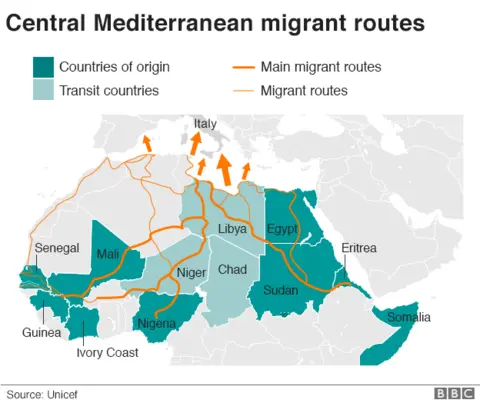Migrant crisis: Spain rescues 600 people in busiest day
Spain's coastguard says it has rescued 600 migrants crossing from Morocco in a 24-hour period, amid a spike in the number of migrant arrivals.
The rescued migrants were in 15 vessels including toy paddleboats and a jet ski and included 35 children and a baby.
The UN says more than 9,000 people have arrived in Spain so far this year - three times as many as the previous year.
More than 120 people are believed to have drowned attempting the crossing.
The increase in crossings means Spain could overtake Greece this year in terms of the number of migrants arriving by sea, the UN's International Organization for Migration (IOM) said earlier this month.
Most are sailing across the 12km (seven-mile) Strait of Gibraltar and many are choosing cheap, child-sized paddle boats without motors that allow them to bypass people-smuggling networks and their fees.
The majority are West Africans, with Nigeria, Guinea and Ivory Coast the top countries of origin. But Bangladeshis have also been leaving North Africa in their thousands.
Unlike Syrians, Iraqis or Afghans arriving in Europe, these groups are mostly treated as economic migrants, rather than refugees.

Pressure on Italy
The numbers heading for Spain are dwarfed by the boatloads that have sailed to Italy this year.
Nearly 100,000 people have crossed from Libya to Italy since the start of the year. The IOM says 2,242 people have died on that route.
In June, about 5,000 people were rescued in one day in the Mediterranean off Libya, Italian coastguards said.
But in July the number crossing to Italy dropped by 57% compared with June, according to the EU's border agency, Frontex. It was the lowest level of arrivals in July since 2014.
Frontex described three factors contributing to that fall: bad weather, clashes in areas of Libya where people-smugglers are active, and more systematic patrolling by Libyan coastguards.
Some migrants are using social media to contact the Spanish authorities and inform them of their location once they are in territorial waters, the BBC's Gavin Lee in the Spanish city of Tarifa says.
The number of migrants arriving in Spain by sea does not include those entering the Spanish enclaves of Ceuta and Melilla in North Africa, which are the EU's only land borders with Africa.
Both enclaves are tightly guarded, and ringed by high fences topped with razor-wire, yet migrants regularly try to storm in, usually at night.

Greece was the main Mediterranean pressure point until March 2016, when the EU reached a deal with Turkey to intercept migrant boats crossing to Greek islands near the Turkish coast.
After that, the numbers on that route dropped sharply. But tighter border controls in the Balkans also made it much harder for migrants to journey to Central Europe.
The death rate among migrants at sea is greater this year than in 2016. The Libya-Italy crossing is longer and more hazardous than the crossings to Greece or Spain.
In other developments:
- Bulgaria's Defence Minister Krasimir Karakachanov said up to 600 soldiers would be deployed along Bulgaria's fenced-off border with Turkey, as an armed deterrent to keep out migrants. He announced the plans in an interview with Germany's Die Welt newspaper
- A Spanish NGO called Proactiva Open Arms accused a Libyan coastguard boat of chasing its vessel Golfo Azzurro north in international waters, preventing it from rescuing migrants at sea. Three charities - Save the Children, Doctors Without Borders (MSF) and Sea Eye - have suspended their rescue work, alleging threats from the Libyan coastguard.

A note on terminology: The BBC uses the term migrant to refer to all people on the move who have yet to complete the legal process of claiming asylum. This group includes people fleeing war-torn countries such as Syria, who are likely to be granted refugee status, as well as people who are seeking jobs and better lives, who governments are likely to rule are economic migrants.
